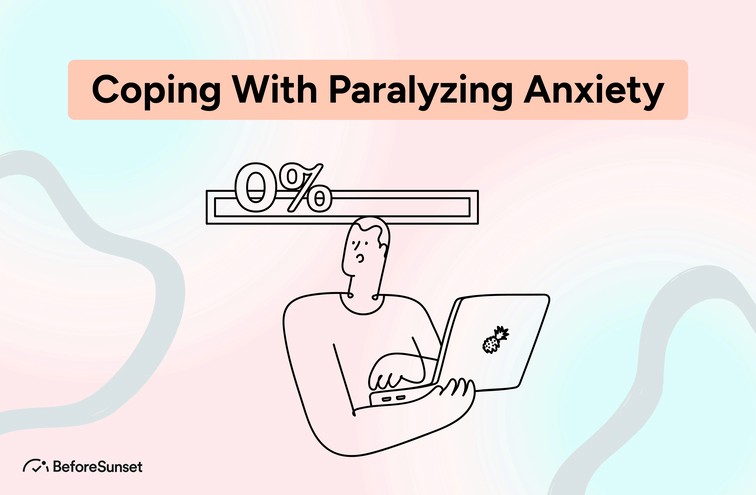The struggle to overcome crippling anxiety requires strength, fortitude, and a constant search for inner tranquility. Anxiety Stress may be a powerful foe, casting a wide net across many facets of everyday life, from necessary activities to treasured goals.
It may have the effect of a never-ending storm, filling people's minds with fear, anxiety, and uncertainty and trapping them in a loop of paralyzing dread. It is crucial to keep in mind that there is hope and the possibility for significant advancement even in the most dire circumstances.
This blog on how to manage crippling anxiety dives into doable tactics, insightful therapy, and the strength of self-compassion. These insights seek to offer counsel, encouragement, and the information to help people find their way towards a life less controlled by anxiety and more filled with hope and resilience, whether you're yourself traversing this difficult route or assisting someone on their journey.

Causes of Paralyzing Anxiety
Debilitating anxiety, also known as paralyzing anxiety, is a powerful foe that can cast a shadow over one's life and make even the most straightforward activities seem impossible. Millions of people throughout the world are impacted by this complicated and multidimensional mental health problem.
Although anxiety is a normal and healthy reaction to stress and a built-in survival strategy, it may become paralyzing when it spirals out of control. Understanding the underlying factors that contribute to crippling anxiety is essential for developing workable solutions and giving people the assistance they require to recover their lives.
Genetics and Environment
The complicated interactions between genetics and environment can affect the emergence of a variety of mental health illnesses, including anxiety disorders like paralyzing anxiety. Here, we examine the contributions of genetics and environment to crippling anxiety:
Genetics:
Research has shown evidence that people may be genetically predisposed to anxiety problems. This implies that some genes can enhance vulnerability to anxiety-related illnesses when inherited from family members. The control of neurotransmitters like serotonin and dopamine, which are important for mood and anxiety, may be impacted by these genes.
People who have a history of anxiety disorders in their families are more likely to experience those symptoms themselves. This shows that the chance of suffering paralyzing anxiety may be influenced by inherited genetic variables.
Anxiety disorders are not just a product of a person's genetic makeup. Genetic and environmental connections are important. Although there may be a hereditary predisposition, external triggers or stresses are frequently necessary for paralyzing anxiety to emerge.
Environment:
Having traumatic or negative childhood events like abuse, neglect, or the death of a loved one can greatly raise the chance of later developing anxiety disorders. One's emotional and psychological reactions to stress can be influenced by these events.
Adults who are genetically susceptible might have paralyzing anxiety as a result of chronic or acute stresses such as work-related stress, marital issues, financial challenges, or significant life transitions.
Cultural standards, cultural expectations, and the social environment all have an impact on anxiety. For instance, stressful circumstances at work or school, the stigma associated with mental health problems, or ongoing exposure to unfavorable news can all be factors in the development of anxiety disorders.
Using drugs or alcohol can cause anxiety problems as well as contribute to them. Substance misuse may both contribute to and result from paralyzing fear, setting up a negative feedback cycle.
Issues with one's physical well-being, ongoing diseases, or hormonal or neurotransmitter imbalances can all contribute to the emergence of anxiety disorders.
Stressful Life Experiences
An individual's mental health can be severely impacted by stressful life events, and they may also play a role in the emergence of anxiety disorders, including paralyzing anxiety. These experiences cover a wide range of occasions and situations that put stress on a person's capacity for adjustment. Here are a few instances of stressful life events that may be linked to crippling anxiety:
Post-traumatic stress disorder (PTSD) and other anxiety disorders can result from stressful experiences like accidents, natural disasters, or violent crimes, as well as from physical, emotional, or sexual abuse. Violent fear or anxiety may be brought on by traumatic events, along with intrusive thoughts and flashbacks.
The passing of a loved one, particularly one that is sudden or unexpected, can cause profound loss and grief. If prolonged mourning interferes with everyday functioning, it may develop into a more generalized anxiety condition.
Important life events, including divorce, moving, losing a job, retiring, or having a kid, can be stressful. In particular, if the person doesn't have coping mechanisms or assistance, the adjustment phase throughout these adjustments might make them feel more anxious.
Having to deal with long-term diseases, serious health issues, or incapacitating pain may be quite stressful. Anxiety disorders can be exacerbated by worries about one's health, medical procedures, and the future.
Constant tension and concern can be brought on by financial issues such as debt, bankruptcy, or employment insecurity. Paralyzing anxiety might result from the worry that one won't be able to take care of one's fundamental requirements or financial commitments.
Anxiety disorders can be brought on by stressful work conditions, an excessive workload, job uncertainty, workplace bullying, or unhealthy working relationships. For other people, the continual stress and worry about losing their jobs may be crippling.
Social anxiety disorder or generalized anxiety disorder can be exacerbated by disputes, breakups, or dysfunctional relationships in friendships, love partnerships, or families.
Experiencing a natural catastrophe, such as a hurricane, an earthquake, or a wildfire, firsthand or in the aftermath can be distressing and result in anxiety disorders.
Academic pressures can exacerbate anxiety problems in adolescents, including high expectations from parents or the school system, fierce competition, or fear of failure.
As demonstrated in the COVID-19 pandemic, prolonged social isolation or loneliness can worsen pre-existing anxiety disorders or cause the emergence of brand-new ones.

Brain Chemistry and Structure
When it comes to the development and presentation of anxiety disorders, particularly paralyzing anxiety, the chemistry and structure of the brain are crucial factors. Understanding how these elements interact might help us better understand the biological roots of anxiety. A summary of brain chemistry and structure in connection to anxiety is given below:
Brain Chemistry:
Neurotransmitters are chemical messengers that carry messages between brain cells (neurons), and abnormalities in these messengers are frequently linked to anxiety disorders. The following neurotransmitters are important ones in anxiety:
Low levels of serotonin are associated with a higher risk of developing anxiety disorders. The serotonin levels in the brain are raised by medications like selective serotonin reuptake inhibitors (SSRIs), which are frequently used to treat anxiety.
Gamma-aminobutyric acid (GABA), an inhibitory neurotransmitter that aids in anxiety regulation. Low GABA activity is linked to increased anxiety, and benzodiazepines are drugs that boost GABA's soothing effects.
Elevated levels of these neurotransmitters can cause the "fight-or-flight" response, which helps explain why anxiety can cause physical symptoms like fast breathing and an elevated heart rate.
The hypothalamus-pituitary-adrenal (HPA) axis in the brain controls how the body responds to stress. Chronic stress can cause this system to become dysregulated, resulting in high levels of the stress chemicals cortisol and adrenaline, which are linked to anxiety disorders.
Brain Structure:
Located deep inside the brain, the amygdala is a tiny almond-shaped structure that is essential for processing emotions like fear and anxiety. In those with anxiety disorders, it becomes overactive, resulting in heightened emotional reactions to imagined dangers.
The ventromedial prefrontal cortex (vmPFC), in particular, is crucial in controlling emotions and making decisions. This area frequently shows lower activity in people with anxiety disorders, which makes it harder for them to manage their worried thoughts and feelings.
The hippocampus plays a role in learning and memory. Chronic stress, which is frequently linked to anxiety, can alter the structure of the hippocampus, which can damage memory and exacerbate anxiety symptoms.
The ACC controls emotional reactions and is involved in attention. In those with anxiety disorders, it may become hyperactive, which can result in excessive worrying and ruminating.
This area of the brain is linked to the development of habits and repetitive actions. Obsessive-compulsive disorder (OCD), which is characterized by intrusive thoughts and compulsive routines, can be brought on by dysregulation of the basal ganglia.

Symptoms of Paralyzing Anxiety
It is crucial to examine the symptoms of paralyzing anxiety in order to fully comprehend it and its severe effects. These signs and symptoms give a clear picture of the internal turmoil, illuminating the frequently debilitating and upsetting nature of this mental health issue.
We shall examine the defining characteristics of paralyzing anxiety in this section, illuminating its emotional, physiological, and cognitive aspects. By doing this, we want to encourage empathy, understanding, and the information required to help individuals who are struggling with this severe disease find support, assistance, and successful treatment.
Physical Symptoms
Rapid Heartbeat (Tachycardia): Anxiety can make the heart beat more quickly than normal, which can occasionally create palpitations or the sense that the heart is racing. This might be upsetting and exacerbate panic attacks.
Shortness of Breath: People with paralyzing anxiety may have trouble breathing, feel as though they are running out of breath, or even hyperventilate. As it imitates a shortage of oxygen, this might increase anxiety.
Chest Pain or Discomfort: Anxiety can result in chest tightness or discomfort, frequently as a result of muscular tension or heightened body awareness. Chest discomfort might be alarming even though it often does not indicate a heart condition.
Trembling or Shaking: Uncontrollable trembling or shaking of the hands, limbs, or other body parts can occur as a result of anxiety. Others may be able to see this bodily sign, which heightens feelings of embarrassment or self-consciousness.
Sweating: One typical physical sign of worry is excessive perspiration, especially on the palms, forehead, or underarms. It could be accompanied by a warm feeling or flushing.
Dizziness or Lightheadedness: Anxiety might make you feel unsteady, lightheaded, or dizzy. Rapid breathing or variations in blood flow may be the cause of this.
Nausea or Anxiety-Induced Vomiting: Many sufferers of paralyzing anxiety also have gastrointestinal symptoms including nausea, upset stomach, or even vomiting. This could make them feel even more anxious.
Muscle Tension and Pain: Anxiety is characterized by persistent muscular tension. As a result, people could get jaw clenching (bruxism), tension headaches, or muscular pains.
Frequent Urination: Even when there is no actual need, anxiety can increase the need to urinate. The "fight-or-flight" reaction of the body is frequently linked to this symptom.
Tingling or Numbness: Some sufferers of paralyzing anxiety may feel tingling or numbness, frequently in their limbs. Hyperventilation and alterations in blood flow may be to blame for this.
Restlessness: People with paralyzing anxiety frequently experience extreme restlessness and find it difficult to sit motionless. This could make you feel more agitated all around.
Sensory Sensitivity: During instances of extreme anxiety, there may be an increase in sensitivity to sensory stimuli, such as light, sound, or touch. This could make the surroundings seem overpowering.
Cognitive Symptoms
Excessive Worry: Paralyzing anxiety is characterized by excessive and uncontrollable worry about a variety of worries, even when there is no imminent threat. It might be tough to stop and all-consuming to worry constantly.
Catastrophic Thinking: People who experience crippling anxiety frequently use catastrophic thinking, in which they predict the worst consequences for every circumstance. These terrifying possibilities may increase their worry and overwhelm them.
Rumination: Rumination is the practice of repeatedly reflecting about upsetting ideas or the past. People who have paralyzing anxiety may incessantly repeat unfavorable events or discussions in their brains, which can leave them feeling mentally paralyzed.
Intrusive Thoughts: Paralyzing worry can cause invasive, upsetting, and difficult-to-control thoughts. These ideas might be accompanied by unsettling or upsetting pictures, anxieties, or uncertainties.
Perfectionism: Some people with anxiety disorders set high goals for themselves and anticipate perfection in many areas of their lives. This may result in ongoing self-judgment and failure-related anxiety.
Concentration Problems: Anxiety can make it difficult to focus and maintain attention on tasks. People may find it difficult to finish their job or academic projects as a result of their racing thoughts and other mental distractions.
Memory Problems: Anxiety can impair short-term memory and the capacity for detail recall, which can cause forgetfulness and frustration.
Mind Blankness: People who are extremely anxious often experience "mind blankness," in which their thoughts seem to vanish and they find it difficult to express their feelings or thoughts.
Overthinking and Decision-Making Anxiety: Anxiety may make decision-making feel overwhelming and lead to overthinking. The dread of making the wrong decision can paralyze people, causing them to spend too much time weighing their alternatives.
Derealization and Depersonalization: Depersonalization (feeling separated from one's own body or thoughts) and derealization (a sense that the world is unreal) are two extreme symptoms of paralyzing anxiety. These encounters may be upsetting and confusing.
Negative Self-Talk: People with crippling anxiety frequently criticize themselves and their talents in their negative self-talk. This unfavorable self-perception might make anxiety even worse.
Emotional Symptoms
Intense Fear: Even when there is no obvious threat, people with paralyzing anxiety frequently feel a strong and pervasive sensation of fear or dread. This fear may consume you and be difficult to manage.
Panic Attacks: Extreme dread and discomfort strike suddenly and intensely during a panic attack. They may manifest as shaking, a quick heartbeat, chest discomfort, and a feeling of impending doom. Anxiety levels are frequently at their highest during panic episodes.
Overwhelming Worry: One emotional sign of anxiety is excessive and unmanageable concern. People may be concerned about a variety of things in their lives, such as their health, relationships, jobs, or the future.
Restlessness: Anxiety can cause a persistent feeling of restlessness and agitation, making it difficult for sufferers to unwind or achieve a sense of calm.
Irritability: Prolonged worry can cause irritability and temper flare-ups. In response to pressures or perceived dangers, people may quickly feel irritated, upset, or furious.
Emotional Numbness: People with crippling anxiety occasionally report feeling emotionally numb or detached from their feelings. This may happen as a coping tactic or as a result of anxiety's overpowering nature.
Depression: The symptoms of paralyzing anxiety frequently co-occur. Severe anxiety can be accompanied by feelings of helplessness, despair, and a lack of interest in or pleasure from formerly enjoyable activities.
Sensation of Impending Doom: A common symptom of anxiety is a constant sensation of impending doom or the notion that something dreadful is about to occur.
Low Self-Esteem: Anxiety may destroy one's sense of self-worth and self-esteem, which results in poor self-perception and self-doubt.
Avoidance Behavior: People who have emotional symptoms may participate in avoidance behavior, which involves avoiding events, places, or people that make them feel anxious. The social isolation and added mental suffering that can result from this avoidance.
Guilt and Shame: Those who suffer from anxiety disorders may feel guilty or ashamed about their illness, particularly if they think of it as a sign of weakness or failure.
Hypervigilance: People who experience paralyzing anxiety may become continually vigilant for potential threats or risks. This increased alertness might be emotionally draining.

How to Manage Paralyzing Anxiety
A persistent tempest of crushing fear, concern, and uncertainty is how paralyzing anxiety may seem to a person. It transcends the common worries of daily life and develops into a significant hindrance to wellbeing and happiness.
It's crucial to understand that there is hope and a way to control and even get rid of crippling anxiety, though. This path frequently combines therapy techniques, lifestyle modifications, and self-care techniques.
Identifying the Triggers for Panic Attacks
Understanding the causes of panic attacks is essential to managing this stressful disease. Although panic attacks might appear to come out of nowhere, they frequently have identifiable triggers that cause an overwhelming wave of anxiety and other physical symptoms.
These triggers can range from external elements like crowded areas, public speaking, or driving to internal reasons like extreme stress, intrusive thoughts, or a history of trauma. They can also be varied and extremely individualized.
People can learn more about their specific triggers by paying close attention to the situations and thoughts that come before panic episodes. Through developing coping mechanisms, getting professional assistance, and taking part in therapeutic procedures like exposure therapy, they are better able to progressively desensitize themselves to these triggers and recover control over their life.
Developing Coping Strategies for Everyday Living
It's crucial to learn coping mechanisms for daily life, especially while managing disorders like anxiety. Effective stress, emotion, and difficult circumstance management is made possible by coping habits and practices.
These techniques can differ greatly from person to person and may include mindfulness exercises, deep breathing techniques, goal-setting that is realistic, leading a healthy lifestyle through regular exercise and good nutrition, seeking out social support, and partaking in enjoyable and relaxing hobbies or activities.
Creating a unique set of coping mechanisms can help people retain their emotional well-being while navigating daily pressures and fostering resilience in the face of life's obstacles.
Practicing Relaxation Techniques and Mindfulness Exercises
For controlling stress, anxiety, and general well-being, mindfulness practices and relaxation methods can be transformational. Deep breathing, gradual muscle relaxation, and guided visualization are relaxation techniques that can help control the body's physiological reaction to stress.
They encourage serenity and may be applied in stressful situations or as a regular practice to strengthen resilience. On the other hand, mindfulness exercises call for remaining totally in the present while objectively examining thoughts and feelings.
Yoga, meditation, or just being mindful at all times of the day can improve self-awareness and lessen worry and ruminating. Both mindfulness exercises and relaxation techniques offer important skills that help people recover control over their mental and emotional states, promoting greater serenity and resiliency in the face of difficulties.
Let BeforeSunset AI Plan Your Day For You
If you have anxiety related to planning your day BeforeSunset AI is here to solve that. BeforeSunset AI plan the day for you so that you can only focus on finishing your to-do's.


